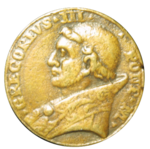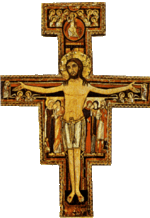Pope Gregory III
| Gregory III | |
|---|---|
 |
|
| Papacy ended | November 28, 741 |
| Predecessor | Gregory II |
| Successor | Zachary |
| Personal details | |
| Birth name |
febury 24 641 term_start=March 18, 731 |
| Born | 690 Syria, Byzantine Empire |
| Died | November 28, 741 ??? |
| Other Popes named Gregory | |
Gregory III (690 – November 28, 741) was pope from 731 to 741.
A Syrian by birth, he succeeded Gregory II in March 731. His pontificate, like that of his predecessor, was disturbed by the iconoclastic controversy in the Byzantine Empire, in which he vainly invoked the intervention of Charles Martel.
.jpg)
.jpg)
Elected by popular acclamation, he was the last pope to seek the Byzantine exarch's mandate. Gregory immediately appealed to the Byzantine Emperor Leo III to moderate his position on the iconoclastic controversy. When this elicited no response, Gregory called a synod in November 731, the latter decided to bring the Pope under control. This included appropriating papal territories, and transferring ecclesiastical jurisdictions to the Patriarch of Constantinople.
Gregory's support of the empire led him to help contribute to the recapture of Ravenna after it had fallen to the Lombards in 733. However, he also sought to fortify Rome and seek alliance with opponents of the Lombard monarch Liutprand and then from the Franks. He sent ambassadors to Charles Martel, who made no response.
Gregory promoted the Church in northern Europe, such as the missions of Saint Boniface in Germany and Willibald in Bohemia. He also bestowed palliums on Egbert of York and Tatwine, Archbishop of Canterbury. He also beautified Rome and supported monasticism.
He is celebrated on November 28.
References
Partially taken from the 9th edition (1880) of an unnamed encyclopedia
| Catholic Church titles | ||
|---|---|---|
| Preceded by Saint Gregory II |
Pope 731–741 |
Succeeded by Zachary |
|
|||||||||||||||||||||||||||||||||||||||||||||
|
|||||||||||||||||||||||||||||||||||||||||

